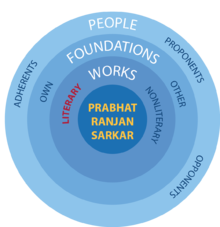Svabhavika Dharma and Bhagavata Dharma: Difference between revisions
(Created page with "{{Infobox discourse | title = <!-- Write the name of the title -->Svábhávika Dharma and Bhágavata Dharma | image = <!--Write image name eg. Example.jpg, do not include "Fil...") |
m (Removed elements that were unclear) |
||
| Line 17: | Line 17: | ||
== Synopsis == | == Synopsis == | ||
{{Quote box|width=360px|bgcolor=|align=left|quoted=1|salign=right|quote=The object of both, svábhávika dharma and Bhágavata dharma, is the same: to get sukham [pleasure]. But in svábhávika dharma the intensity of sukham is limited, while in Bhágavata dharma it is beyond any measure, it is ananta | {{Quote box|width=360px|bgcolor=|align=left|quoted=1|salign=right|quote=The object of both, svábhávika dharma and Bhágavata dharma, is the same: to get sukham [pleasure]. But in svábhávika dharma the intensity of sukham is limited, while in Bhágavata dharma it is beyond any measure, it is ''ananta''.|source=Shrii Shrii Anandamurti}} | ||
Anandamurti starts the discourse by saying that Dharma can be separated into two categories: ''svábhávika dharma'' (pertaining to the sustenance of the body) and Bhágavata dharma (longing for infinite happiness). Human beings are different from animals in | Anandamurti starts the discourse by saying that Dharma can be separated into two categories: ''svábhávika dharma'' (pertaining to the sustenance of the body) and Bhágavata dharma (longing for infinite happiness). Human beings are different from animals in that human beings can attain unlimited happiness. Anandamurti then explains the four elements of ''Bhágavata dharma''.<ref name="AV33"/> | ||
== References == | == References == | ||
{{reflist}} | {{reflist}} | ||
Latest revision as of 17:15, 14 April 2020
| Svábhávika Dharma and Bhágavata Dharma | |
|---|---|
| Speaker | Shrii Shrii Anandamurti |
| Date | 1969 |
| Time | Unknown |
| Place | Unknown |
| Topic | Human beings long for infinite happiness |
| Included in | Ananda Vacanamrtam Part 33 |
| Location in Sarkarverse | |
Svábhávika Dharma and Bhágavata Dharma is a discourse given by Shrii Shrii Anandamurti in 1969. This discourse is the third chapter of Ananda Vacanamrtam Part 33.[1]
Synopsis
The object of both, svábhávika dharma and Bhágavata dharma, is the same: to get sukham [pleasure]. But in svábhávika dharma the intensity of sukham is limited, while in Bhágavata dharma it is beyond any measure, it is ananta.
Anandamurti starts the discourse by saying that Dharma can be separated into two categories: svábhávika dharma (pertaining to the sustenance of the body) and Bhágavata dharma (longing for infinite happiness). Human beings are different from animals in that human beings can attain unlimited happiness. Anandamurti then explains the four elements of Bhágavata dharma.[1]
References
| Preceded by The Three Vital Factors |
Ananda Vacanamrtam Part 33 With: Svábhávika Dharma and Bhágavata Dharma |
Succeeded by Scope for Environmental Adjustment |
